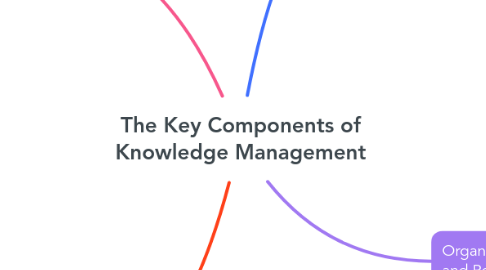The Key Components of Knowledge Management
von Mindmeister Admin


1. Processes and Practices
1.1. Processes help us capture, curate, and share knowledge. Organizations must embrace and integrate these formal and informal processes into their daily workflows to be successful.
1.2. Value Chain
1.2.1. Problem Solving
1.2.2. Best Practices
1.2.3. Innovation
1.2.4. Learning
1.3. Supporting Infrastructure
1.3.1. Event Planning
1.3.2. Membership Support
1.3.3. Content Coordination
1.3.4. Website Development
2. Technology
2.1. Technology, while a valuable tool, merely plays a supporting role to the real star of the show: knowledge. Information and communication technology that is appropriate to the context can expedite knowledge storage, retrieval, and exchange.
2.2. Knowledge Systems
2.2.1. Collaboration Tools
2.2.1.1. Web-based
2.2.1.2. Real-time
2.2.1.3. Across devices
2.2.1.4. Example: MindMeister
2.2.2. Expert Locators
2.2.2.1. "Who's Who"
2.2.2.2. Connecting People
2.2.3. Document Management
2.2.3.1. Version Management
2.2.4. Calendars
2.2.4.1. Shared Across Teams
2.2.4.2. Integrated with Collaboration Tools
3. Definition of KM
3.1. "Knowledge Management is the process of capturing, distributing, and effectively using knowledge."
3.1.1. The classic definition of KM by Tom Davenport (1994).
3.2. "Knowledge management is a discipline that promotes an integrated approach to identifying, capturing, evaluating, retrieving, and sharing all of an enterprise's information assets. These assets may include databases, documents, policies, procedures, and previously un-captured expertise and experience in individual workers."
3.2.1. The most cited definition by Bryant Duhon (1998) from the Gartner Group.
4. Organizations and People
4.1. People generate, capture, share, and apply knowledge, primarily through human interaction. People can help cultivate an environment that encourages knowledge exchange and use of knowledge management systems.
4.2. Structure
4.2.1. Work Teams
4.2.2. CoPs
4.2.3. Expertise Networks
4.3. Culture
4.3.1. Values
4.3.2. Behaviors
4.3.3. Attitudes

